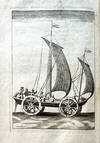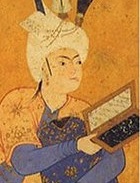first edition
1695 · London:
by WILKINS, John (1614-1672).
London:: Printed for Nathaniel Rolls, at his auction house, 1695., 1695. Two parts (books) in one. Small 8vo. [iii-xvi], 295, [1] pp. Figures (including full-page figs. on pp. 98, 158, 160, 296); waterstaining prominently through page 16, diminishing rapidly after, and at the rear, from p. 219 both the lower gutter and outer margin are stained. Original modern brown calf, blind-ruled covers, raised bands, gilt-tooling to the spine, burgundy label. Very good, though with waterstains. [C329:346] Fourth edition. The first edition was issued in 1648. Written at a time where experimental philosophy was just finding favor among membership of the Royal Society. Wilkins had just become Warden of Wadham College, Oxford, and surrounding him were Fellows, each a learned man of science, and members of the Oxford Philosophical Club (the precursor to the Royal Society): Christopher Wren, Walter Pope, Thomas Sprat, William Lloyd, William Neile, Samuel Parker. Others have held Wilkins in high esteem, included among these are his corresponding colleagues, Robert Boyle, Robert Hooke, Isaac Newton (his student), and Henry Oldenberg. / ". . . the first text on mechanics available in the English language . . . describing various machines, including strange devices and possibilities, such as a land vehicle powered by wind, submarines, flying automata, clocks, magnetic perpetuum mobile, etc." --Bibliotheca Mechanica, page 354. / "Wilkins dedicated his work to His Highness the Prince Elector Palatine (Charles I Louis) who was in London at the time. It is divided into two books, one headed Archimedes, because he was the chiefest in discovering of Mechanical powers, the other was called Daedalus because he was one of the first and most famous amongst the Ancients for his skill in making Automata. Wilkins sets out and explains the principles of mechanics in the first book and gives an outlook in the second book on future technical developments like flying which he anticipates as certain if only sufficient exercise, research and development would be directed to these topics". [Wikip.] "In the 20 chapters of the first book, traditional mechanical devices are discussed such as the balance, the lever, the wheel or pulley and the block and tackle, the wedge, and the screw. The powers acting on them are compared to those acting in the human body. The book deals with the phrase attributed to Archimedes saying that if he did but know where to stand and fasten his instrument, he could move the world and shows the effect of a series of gear transmissions one linked to the other. It shows the importance of various speeds and the theoretical possibility to increase speed beyond the speed of the earth at the equator. Finally, siege engines like catapults are compared with the cost and effect of then-modern guns". / "In the 15 chapters of the second book, various devices are examined which move independently of human interference like clocks and watches, water mills and wind mills. Wilkins explains devices being driven by the motion of air in a chimney or by pressurized air. A land yacht is proposed driven by two sails on two masts, and a wagon powered by a vertical axis wind turbine. A number of independently moving small artificial figures representing men and animals are described. The possibilities are considered to improve the type of submarine designed and built by Cornelis Drebbel. The tales about various flying devices are related and doubts as to their truth are dissipated. Wilkins explains that it should be possible for a man, too, to fly by himself if a frame were built where the person could sit and if this frame was sufficiently pushed in the air". / "In chapter VII, Wilkins discusses various methods how a man could fly, namely by the help of spirits and good or evil angels (as related on various occasions in the Bible), by the help of fowls, by wings fastened immediately to the body or by a flying chariot. The whole of this chapter (and of the following one) concern the possibilities of flying.” Wilkins continues by saying that sufficient practice should enable a man to fly. The most probable way, however, would be by a flying chariot, which may be so contrived as to carry a man within it . . . and be equipped with some sort of engine, or else be big enough to carry several persons each of them successively laboring to cause the chariot to fly. Wilkins uses the next chapter to dissipate any doubts there may be as to the possibility of such a flying chariot, but of course a number of particular items would have to be developed and tested. "In Chapters IX to XV, extensive discussions and deliberations are set out why a perpetual motion should be feasible, why the stories about lamps burning for hundreds of years were true and how such lamps could be made and perpetual motions created". [Wikip.]. / See: DSB [Hans Aarsleff], XIV, pp. 361-381; Sotheby, Honeyman VII, 3120; Sotheby's The Library of the Earls of Macclesfield, Part 6, p. 362, no. 2126; Raymond Toole Stott, A Bibliography of English Conjuring 1581-1876, p. 280, no. 883; Tomash & Williams W74; ESTC R6164; Wing W2198.
(Inventory #: S14297)










